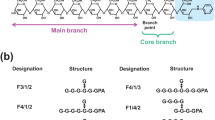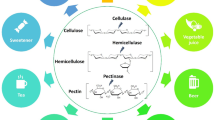Summary
Two previously purified esterases of Trichoderma reesei were used to study the deacetylation of polymeric, oligomeric and dimeric acetylated xylan fragments. For the first time nearly complete enzymatic deacetylation of polymeric xylan with purified acetyl xylan esterase was demonstrated, resulting in precipitation of the remaining polymer structure. The esterases had very different substrate specifities, one having a preference for high molecular weight substrates and the other showing high activity only towards acetyl xylobiose. The latter enzyme was also regioselective, cleaving off the acetyl substituent only from the C-3 position of the xylopyranose ring. The highest xylose yield from acetylated xylan was obtained by the synergistic action of xylanase, \-xylosidase and acetyl xylan esterase.
Similar content being viewed by others
References
Bacon JSD, Gordon AH, Morris EJ (1975) Acetyl groups in cell-wall preparations from higher plants. Biochem J 149:485–487
BeMiller JN (1986) An introduction to pectins: structure and properties. In: Fishman ML, Jen JJ (eds) Chemistry and function of pectins. ACS Symposium Series 310, American Chemical Society, Washington, DC, pp 2–12
Biely P, Puls J, Schneider H (1985) Acetyl xylan esterases in fungal cellulolytic systems. FEBS Lett 186:80–84
Biely P, MacKenzie CR, Puls J, Schneider H (1986) Cooperativity of esterases and xylanases in the enzymatic degradation of acetyl xylan. Bio/Technology 4:731–733
Biely P, MacKenzie CR, Schneider H, Puls J (1987) The role of fungal acetyl xylan esterases in the degradation of acetyl xylan by fungal xylanases. In: Kennedy JF, Philips GO, Williams PA (eds) Wood and cellulosics: industrial utilization, biotechnology, structure and properties. Ellis Hordwood, Chichester, pp 283–289
Bouveng HO (1961) Phenylisocyanate derivatives of carbohydrates II. Location of O-acetyl groups in birch xylan. Acta Chem Scand 15:96–100
Frohwein YZ, Zori U, Leibowitz J (1963) The enzymatic hydrolysis of fully and partially acetylated sugar derivatives IV. Enzymologia 26:193–200
Grohmann K, Mitchell DJ, Himmel ME, Dale BE, Schroeder HA (1989) The role of ester groups in resistance of plant cell wall polysaccharides to enzymatic hydrolysis. Appl Biochem Biotechnol 20/21:45–61
Hägglund E, Lindberg B, McPherson J (1956) Dimethylsulphoxide, a solvent for hemicelluloses. Acta Chem Scand 10:1160–1164
Lindberg B, Rosell K-G, Svensson S (1973a) Positions of the O-acetyl groups in birch xylan. Sven Papperstidn 76:30–32
Lindberg B, Rosell K-G, Svensson S (1973b) Position of the O-acetyl groups in pine glucomannan. Sven Papperstidn 76:383–384
Matsuo T, Mizuno T (1974) Acetyl groups in native glucomannan from ester lily bulbs. Agric Biol Chem 38:465–466
Morris EJ, Bacon JSD (1977) The fate of acetyl groups and sugar components during the digestion of grass cell walls in sheep. J Agric Sci Camb 89:327–340
Poutanen K (1988) Characterization of xylanolytic enzymes for potential applications. Thesis, Technical Research Centre of Finland, Publications 47, Espoo
Poutanen K, Puls J (1988) Characteristics of Trichoderma reesei β-xylosidase and its use in the hydrolysis of solubilized xylans. Appl Microbiol Biotechnol 28:425–432
Poutanen K, Puls J (1989) The xylanolytic enzyme system of Trichoderma reesei. In: Lewis N, Paice M (eds) Plant cell wall polymers. Biogenesis and biodegradation, ACS Symp Ser 399, American Chemical Society, Washington, DC, pp 630–640
Poutanen K, Sundberg M (1988) An acetyl esterase of Trichoderma reesei and its role in the hydrolysis of acetyl xylans. Appl Microbiol Biotechnol 28:419–424
Poutanen K, Puls J, Linko M (1986) The hydrolysis of steamed birchwood hemicellulose by enzymes produced by Trichoderma reesei and Aspergillus awamori. Appl Microbiol Biotechnol 23:487–490
Poutanen K, Rättö M, Puls J, Viikari L (1987) Evaluation of different microbial xylanolytic systems. J Biotechnol 6:49–60
Poutanen K, Bailey M, Sundberg M, Rättö M, Puls J (1990) Enzymatic solubilization of xylans. In: Proceedings of the 4th International Congress of Biotechnology in the Pulp and Paper Industry, Raleigh, USA, 16–19 May 1989. Butterworth Scientific, pp 559–565
Puls J, Poutanen K, Körner H-U, Viikari L (1985) Biotechnical utilization of wood carbohydrates after steaming pretreatment. Appl Microbiol Biotechnol 22:416–423
Sundberg M, Poutanen K (1990) Purification and properties of two acetyl xylan esterases of Trichoderma reesei. Biotechnol Appl Biochem, in press
Wood TM, McCrae SI (1986) The effect of acetyl groups on the hydrolysis of ryegrass cell walls by xylanase and cellulase of Trichoderma koningii. Phytochemistry 25:1053–1055
Author information
Authors and Affiliations
Additional information
Offprint requests to: M. Sundberg
Rights and permissions
About this article
Cite this article
Poutanen, K., Sundberg, M., Korte, H. et al. Deacetylation of xylans by acetyl esterases of Trichoderma reesei . Appl Microbiol Biotechnol 33, 506–510 (1990). https://doi.org/10.1007/BF00172542
Received:
Accepted:
Issue Date:
DOI: https://doi.org/10.1007/BF00172542




